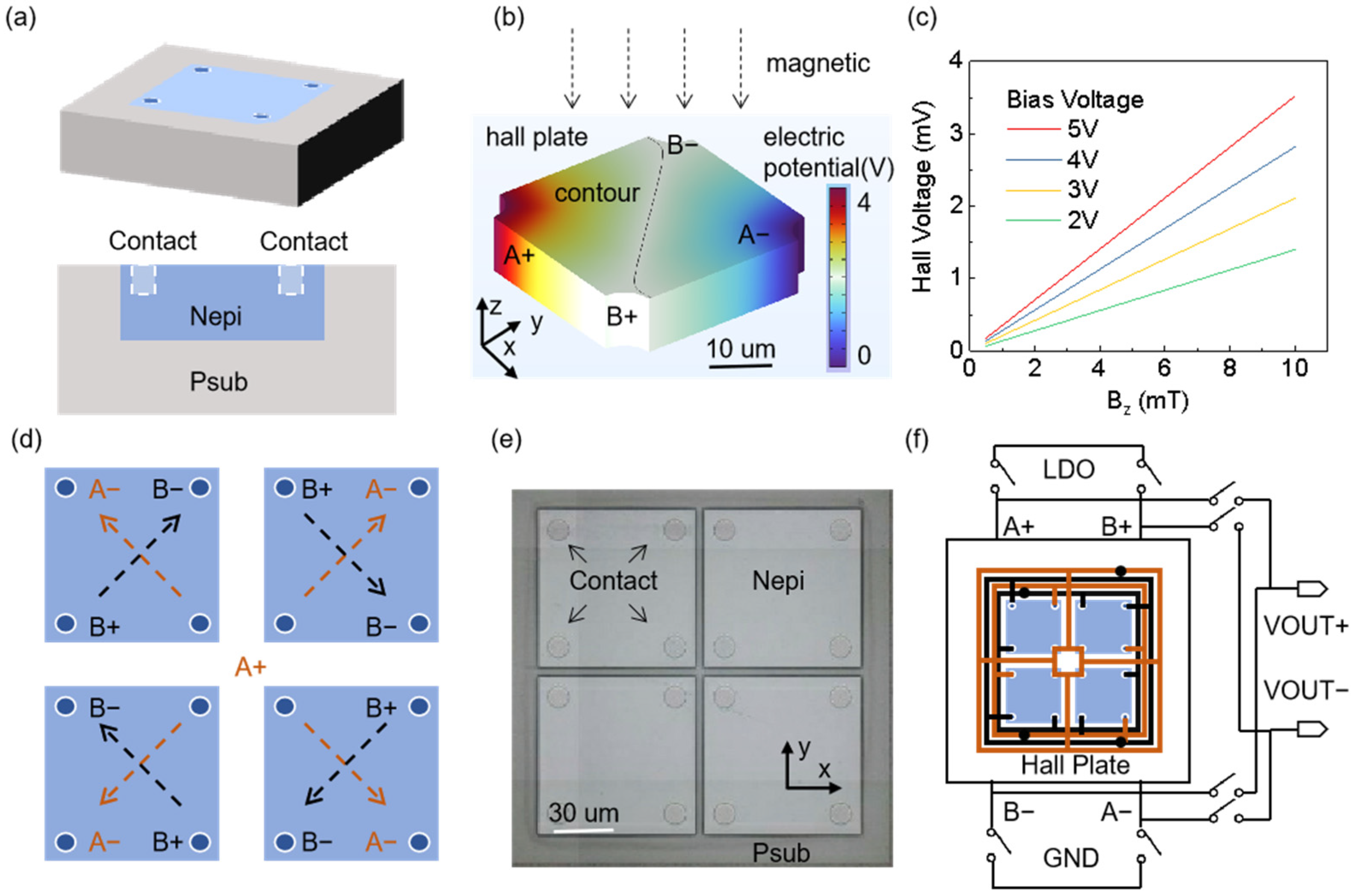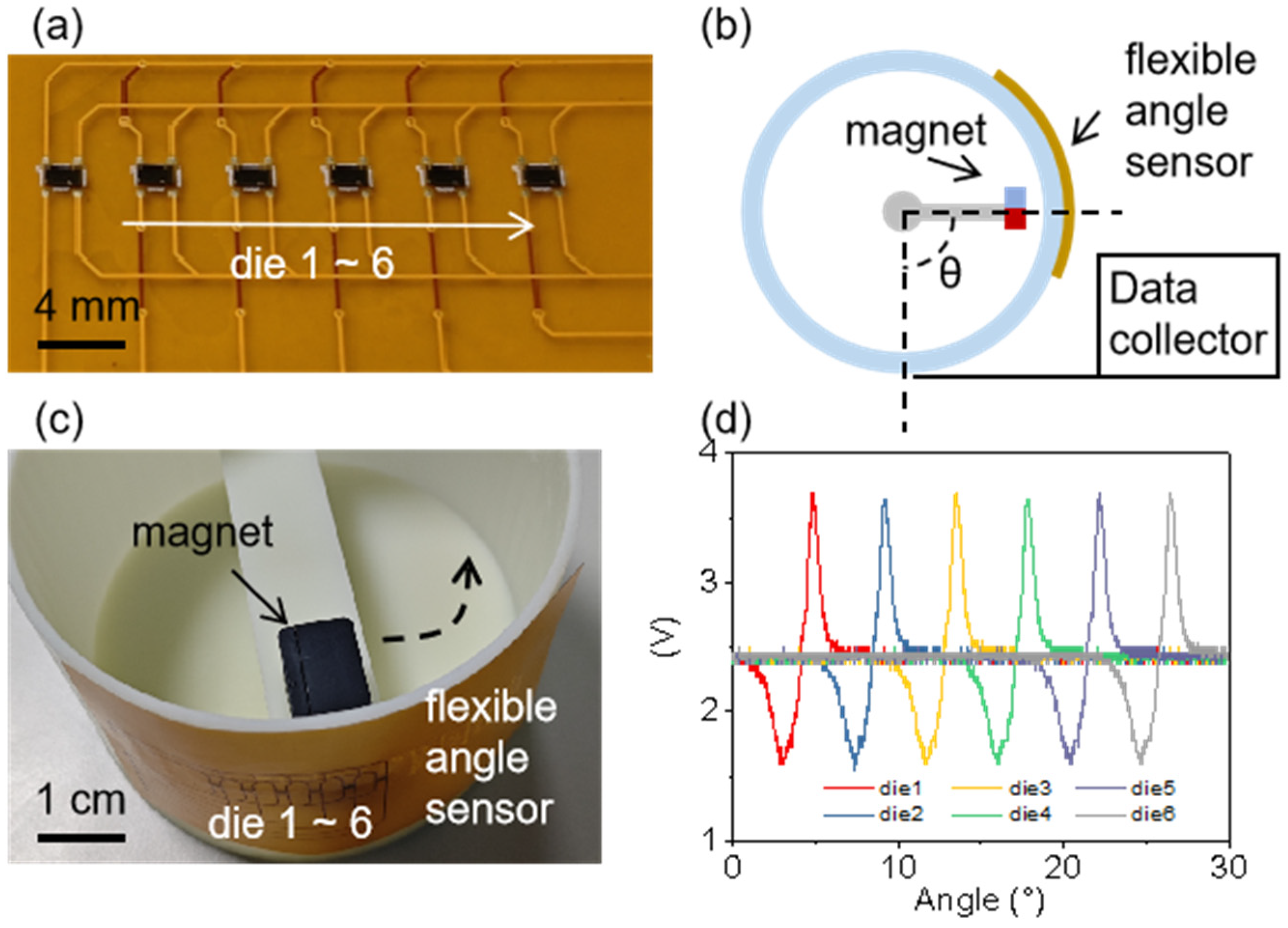Flexible Hybrid Integration Hall Angle Sensor Compatible with the CMOS Process
Abstract
1. Introduction
2. Design and Fabrication
3. Results and Discussion
4. Conclusions
Author Contributions
Funding
Institutional Review Board Statement
Informed Consent Statement
Data Availability Statement
Acknowledgments
Conflicts of Interest
References
- Cao, B.; Lei, K.-M.; Zou, H.; Martins, R.P.; Mak, P.-I. Exploring the Performance of Hall Sensor with Substrate Bias Modulation in SOI Process. IEEE Sens. J. 2024, 24, 27365–27372. [Google Scholar] [CrossRef]
- Dung, T.T.H.; Trung, L.Q.; Kasai, N.; Le, M.; Luong, V.S. Development of differential hall sensors for pulsed eddy current testing using gaussian pulse excitation. Sens. Actuators A 2024, 379, 115998. [Google Scholar] [CrossRef]
- Gibiino, G.P.; Marchesi, M.; Cogliati, M.; Syeda, S.F.; Romani, A.; Traverso, P.A.; Crescentini, M. Experimental evaluation of Hall-effect current sensors in BCD10 technology. Measurement 2023, 220, 113289. [Google Scholar] [CrossRef]
- Lee, J.; Lee, D.; Jeong, M.; Kang, D. Research on hall sensor fault diagnosis and compensation method to improve motor control reliability. J. Magn. 2018, 23, 648–653. [Google Scholar] [CrossRef]
- Okuyama, T.; Kobayashi, K.; Otsuki, M.; Tanaka, M. Measurement of finger joint angle using a flexible polymer sensor. Int. J. Appl. Electromagn. Mech. 2016, 52, 951–957. [Google Scholar] [CrossRef]
- Wang, Z.G.; Wang, X.J.; Li, M.H.; Gao, Y.; Hu, Z.Q.; Nan, T.X.; Sun, N.X. Highly sensitive flexible magnetic sensor based on anisotropic magnetoresistance effect. Adv. Mater. 2016, 28, 9370–9379. [Google Scholar] [CrossRef]
- Wouters, C.; Vranković, V.; Rössler, C.; Sidorov, S.; Ensslin, K.; Wegscheider, W.; Hierold, C. Design and fabrication of an innovative three-axis Hall sensor. Sens. Actuators A Phys. 2015, 237, 62–71. [Google Scholar] [CrossRef]
- Masias, A.; Marcicki, J.; Paxton, W.A. Opportunities and Challenges of Lithium Ion Batteries in Automotive Applications. ACS Energy Lett. 2021, 6, 621–630. [Google Scholar] [CrossRef]
- Paliwal, S.; Yenuganti, S.; Manuvinakurake, M. Fabrication and testing of a Hall effect based pressure sensor. Sens. Rev. 2022, 42, 354–364. [Google Scholar] [CrossRef]
- Ishibashi, K.; Okada, I.; Shibasaki, I. High sensitivity hybrid Hall effect ICs with thin film hall elements. Sens. Mater. 2002, 14, 253–261. [Google Scholar]
- Chuang, Y.-C.; Cheng, T.-Y.; Tsai, Y.-C. Flexible Printed Circuit Board Strain Sensor Embedded in a Miniaturized Pneumatic Finger. IEEE Sens. J. 2022, 22, 22456–22463. [Google Scholar] [CrossRef]
- Hong, W.Q.; Guo, X.H.; Zhang, T.X.; Mu, S.W.; Wu, F.; Yan, Z.H.; Zhao, Y.N. Flexible strain sensor based on nickel microparticles/carbon black microspheres/polydimethylsiloxane conductive composites for human motion detection. ACS Appl. Mater. Interfaces 2024, 16, 32702–32712. [Google Scholar] [CrossRef]
- Jang, H.; Park, Y.J.; Chen, X.; Das, T.; Kim, M.; Ahn, J. Graphene-Based Flexible and Stretchable Electronics. Adv. Mater. 2016, 28, 4184–4202. [Google Scholar] [CrossRef] [PubMed]
- Jia, X.; Guo, R.; Tay, B.K.; Yan, X. Flexible Ferroelectric Devices: Status and Applications. Adv. Funct. Mater. 2022, 32, 2205933. [Google Scholar] [CrossRef]
- Lee, H.; Kim, M.; Kim, I.; Lee, H. Flexible and stretchable optoelectronic devices using silver nanowires and graphene. Adv. Mater. 2016, 28, 4541–4548. [Google Scholar] [CrossRef]
- Karnaushenko, D.; Makarov, D.; Stöber, M.; Karnaushenko, D.D.; Baunack, S.; Schmidt, O.G. High performance magnetic sensorics for printable and flexible electronics. Adv. Mater. 2015, 27, 880–885. [Google Scholar] [CrossRef]
- Liu, W.L.; Liu, M.; Ma, R.; Zhang, R.Y.; Zhang, W.Q.; Yu, D.P.; Wang, H. Mechanical strain-tunable microwave magnetism in flexible CuFe2O4 epitaxial thin film for wearable sensors. Adv. Funct. Mater. 2018, 28, 201705928. [Google Scholar] [CrossRef]
- Yang, H.L.; Li, S.B.; Wu, Y.Z.; Bao, X.L.; Xiang, Z.Y.; Xie, Y.L.; Li, R.W. Advances in flexible magnetosensitive materials and devices for wearable electronics. Adv. Mater. 2024, 36, e2311996. [Google Scholar] [CrossRef]
- Zang, Y.; Zhang, F.; Huang, D.; Di, C.; Zhu, D. Sensitive Flexible Magnetic Sensors using Organic Transistors with Magnetic-Functionalized Suspended Gate Electrodes. Adv. Mater. 2015, 27, 7979–7985. [Google Scholar] [CrossRef]
- Chen, Y.; Sun, Y.; Wei, Y.; Qiu, J. How Far for the Electronic Skin: From Multifunctional Material to Advanced Applications. Adv. Mater. Technol. 2023, 8, 202201352. [Google Scholar] [CrossRef]
- Ji, D.; Zhu, Y.; Li, M.; Fan, X.; Zhang, T.; Li, Y. Skin Comfort Sensation with Mechanical Stimulus from Electronic Skin. Materials 2024, 17, 2920. [Google Scholar] [CrossRef]
- Ma, Z.; Ding, C.; Li, L.; Tian, B. The Design of Decoupled Robotic Arm Based on Chain Transmission. Machines 2024, 12, 410. [Google Scholar] [CrossRef]
- Wang, Y.; Wu, W.; Li, S.; Jiang, Y.; Zang, W.; Fu, W.; Zhang, L. A soft mimic robotic arm powered by dielectric elastomer actuator. Adv. Funct. Mater. 2024, 34, 202411229. [Google Scholar] [CrossRef]
- Luo, Y.; Sun, C.; Ma, H.; Wei, M.; Li, J.; Jian, J.; Li, L. Flexible passive integrated photonic devices with superior optical and mechanical performance. Opt. Express 2022, 30, 26534–26543. [Google Scholar] [CrossRef] [PubMed]
- Luo, Y.; Sun, C.; Wei, M.; Ma, H.; Wu, Y.; Chen, Z.; Dai, H.; Jian, J.; Sun, B.; Zhong, C.; et al. Integrated Flexible Microscale Mechanical Sensors Based on Cascaded Free Spectral Range-Free Cavities. Nano Lett. 2023, 23, 8898–8906. [Google Scholar] [CrossRef] [PubMed]
- Han, S.; Kim, J.; Won, S.M.; Ma, Y.; Kang, D.; Xie, Z.; Rogers, J.A. Battery-free, wireless sensors for full-body pressure and temperature mapping. Sci. Transl. Med. 2018, 10, eaan4950. [Google Scholar] [CrossRef] [PubMed]
- Gutruf, P.; Yin, R.T.; Lee, K.B.; Ausra, J.; Brennan, J.A.; Qiao, Y.; Rogers, J.A. Wireless, battery free, fully implantable multimodal and multisite pacemakers for applications in small animal models. Nat. Commun. 2019, 10, 5742. [Google Scholar] [CrossRef]
- Wang, Y.; Hasegawa, T.; Matsumoto, H.; Michinobu, T. Correction to “Significant Improvement of Unipolar n-Type Transistor Performances by Manipulating the Coplanar Backbone Conformation of Electron-Deficient Polymers via Hydrogen Bonding”. J. Am. Chem. Soc. 2021, 143, 21443. [Google Scholar] [CrossRef] [PubMed]
- Wang, Y.; Guo, H.; Harbuzaru, A.; Uddin, M.A.; ArrecheaMarcos, I.; Ling, S.; Guo, X. (Semi)ladder-type bithiophene imide-based all-acceptor semiconductors: Synthesis, structure-property correlations, and unipolar n-type transistor performance. J. Am. Chem. Soc. 2018, 140, 6095–6108. [Google Scholar] [CrossRef] [PubMed]
- Yuan, Y.; Giri, G.; Ayzner, A.L.; Zoombelt, A.P.; Mannsfeld, S.C.B.; Chen, J.; Nordlund, D.; Toney, M.F.; Huang, J.; Bao, Z. Ultra-high mobility transparent organic thin film transistors grown by an off-centre spin-coating method. Nat. Commun. 2014, 5, 3005. [Google Scholar] [CrossRef]
- Daus, A.; Vaziri, S.; Chen, V.; Köroğlu, Ç.; Grady, R.W.; Bailey, C.S.; Lee, H.R.; Schauble, K.; Brenner, K.; Pop, E. High-performance flexible nanoscale transistors based on transition metal dichalcogenides. Nat. Electron. 2021, 4, 495–501. [Google Scholar] [CrossRef]
- Wang, Z.; Shaygan, M.; Otto, M.; Schall, D.; Neumaier, D. Flexible Hall sensors based on graphene. Nanoscale 2016, 8, 7683–7687. [Google Scholar] [CrossRef]
- Morvic, M.; Betko, J. Planar Hall effect in Hall sensors made from InP/InGaAs heterostructure. Sens. Actuators A Phys. 2005, 120, 130–133. [Google Scholar] [CrossRef]
- Xu, Y.; Lalwani, A.V.; Arora, K.; Zheng, Z.; Renteria, A.; Senesky, D.G.G.; Wang, P. Hall-effect sensor design with physics-informed gaussian process modeling. IEEE Sens. J. 2022, 22, 22519–22528. [Google Scholar] [CrossRef]
- Paun, M.-A.; Sallese, J.-M.; Kayal, M. Hall Effect Sensors Design, Integration and Behavior Analysis. J. Sens. Actuator Netw. 2013, 2, 85–97. [Google Scholar] [CrossRef]
- Riem, R.; Raman, J.; Rombouts, P. A 2 MS/s Full Bandwidth Hall System with Low Offset Enabled by Randomized Spinning. Sensors 2022, 22, 6069. [Google Scholar] [CrossRef] [PubMed]
- Heeley, A.D.; Hobbs, M.J.; Willmott, J.R. Zero Drift Infrared Radiation Thermometer Using Chopper Stabilised Pre-Amplifier. Appl. Sci. 2020, 10, 4843. [Google Scholar] [CrossRef]
- Kusuda, Y. A 5.6 nv/√hz chopper operational amplifier achieving a 0.5 μv maximum offset over rail to rail input range with adaptive clock boosting technique. IEEE J. Solid-State Circuits 2016, 51, 2119–2128. [Google Scholar] [CrossRef]
- Oh, J.Y.; Lee, Y.; Lee, T. Skin-mountable functional electronic materials for bio-integrated devices. Adv. Healthc. Mater. 2024, 13, 202303797. [Google Scholar] [CrossRef]
- Donolato, M.; Tollan, C.; Porro, J.M.; Berger, A.; Vavassori, P. Flexible and Stretchable Polymers with Embedded Magnetic Nanostructures. Adv. Mater. 2012, 25, 623–629. [Google Scholar] [CrossRef] [PubMed]





Disclaimer/Publisher’s Note: The statements, opinions and data contained in all publications are solely those of the individual author(s) and contributor(s) and not of MDPI and/or the editor(s). MDPI and/or the editor(s) disclaim responsibility for any injury to people or property resulting from any ideas, methods, instructions or products referred to in the content. |
© 2025 by the authors. Licensee MDPI, Basel, Switzerland. This article is an open access article distributed under the terms and conditions of the Creative Commons Attribution (CC BY) license (https://creativecommons.org/licenses/by/4.0/).
Share and Cite
Luo, Y.; Fang, Y.; Lv, Y.; Zheng, H.; Guan, K. Flexible Hybrid Integration Hall Angle Sensor Compatible with the CMOS Process. Sensors 2025, 25, 927. https://doi.org/10.3390/s25030927
Luo Y, Fang Y, Lv Y, Zheng H, Guan K. Flexible Hybrid Integration Hall Angle Sensor Compatible with the CMOS Process. Sensors. 2025; 25(3):927. https://doi.org/10.3390/s25030927
Chicago/Turabian StyleLuo, Ye, Youtong Fang, Yang Lv, Huaxiong Zheng, and Ke Guan. 2025. "Flexible Hybrid Integration Hall Angle Sensor Compatible with the CMOS Process" Sensors 25, no. 3: 927. https://doi.org/10.3390/s25030927
APA StyleLuo, Y., Fang, Y., Lv, Y., Zheng, H., & Guan, K. (2025). Flexible Hybrid Integration Hall Angle Sensor Compatible with the CMOS Process. Sensors, 25(3), 927. https://doi.org/10.3390/s25030927




